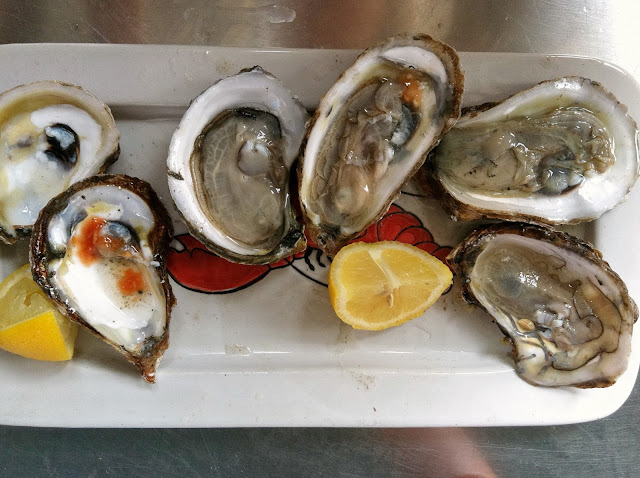The Kitchen Goddess has not deserted you. She’s in Ireland, getting her fill of crusty brown bread and Irish soda bread and fresh trout and some fabulous cake with a caramel sauce whose name I can’t remember. So posting has been a bit of a trial, but here I am at last.
One of my responsibilities as a grandmother is to send my granddaughter postcards from my travels. She’s 3½, so she loves getting the mail, which is how I found myself at the post office in Ennis, Ireland, yesterday.
It’s a tiny affair with a prison-cell decor, and barely large enough for the 15 or so people who stood patiently in a line that snaked almost out the door. Only one service window was open, and with nothing else to do while I waited to buy stamps, I checked out the other customers.
Directly in front of me, a young man, maybe in his late 20s, chatted quietly with a slightly older woman, in a language I didn’t recognize. She handed him the pile of post cards she was mailing. As he rifled through them, I noticed they were all addressed to Poland.
He bent affectionately toward her as he talked, and I heard, “[Polish Polish Polish]...six stamps to Poland.” He handed her back the stack of cards and repeated, “Six stamps to Poland.”
She shook her head, obviously embarrassed, and responded, “[Polish Polish Polish],” as she tried to get him to take the cards back.
He refused, and the debate continued. Each time he gently insisted, “Six stamps to Poland,” she shook her head “No.”
As their turn at the window approached, I couldn’t stay silent any longer. I tapped her on the shoulder, and said, “You can do it. Six stamps to Poland.”
She smiled nervously, and he nodded. He turned to me and said, “She comes every year and I try to learn her some English. But no.” Then he added, “She learns Russian, but not English.”
Finally, it was her turn. They walked up to the window, and as she pushed her cards over to the postal clerk, she leaned in and I heard a soft, “Six stamps to Poland.”
They were both grinning as they walked out into the afternoon.
* * *
Cooking and food can present much that same sort of challenge. All too often, when you come across a new technique or a new taste to master, you may have a tendency to say, “I can’t do that.” Phooey. Of course you can – it’s only food. The Kitchen Goddess encourages you to join her as she shouts, “Six stamps to Poland!” and go for it.
Most recently, the challenge I faced was nothing more than an overstuffed fridge and a vacation deadline. “What’ll I do with all this fruit?!” I asked myself. That would be 3½ pounds of sugar plums on the verge of overripening and four small containers of blackberries. Yikes. (Don’t worry, I’ve cut the quantities down to more manageable portions for you.) I could have made jam, but decided instead that what I really wanted was compote.
So first I had to look up “compote” to make sure I had the concept right. Yes, it’s just what I thought – a sort of dessert topping made from whole or chunked fruit in a simple sugar syrup. Very light and fruity without being jammy. Then you put it on ice cream or pound cake for dessert, or stir it into your morning yogurt, or serve it as an appetizer with goat cheese and crackers. Very flexible, and simple as pie – really much simpler than pie.
And just to show you what a swell person the Kitchen Goddess is, I’ve also included a summer fruit dessert – broiled peaches – that uses the compote. What a great way to celebrate summer!
Plum-Blackberry Compote
Makes about 3 cups.¾ cup sugar
1½ pounds plums (any type of plum should do – I had sugar plums), seeded and cut into quarters if small, eighths if large
zest of ½ lemon
2 cups blackberries
1½ tablespoons lemon balsamic vinegar (or regular balsamic vinegar plus ½ teaspoon lemon juice)
Put the sugar into a large saucepan with 1 cup water, and bring to a boil over medium heat, stirring just until the sugar dissolves. Boil 5 minutes then add the plums and lemon zest. Cook the plums at a low boil for 5 minutes, then add blackberries and vinegar and simmer another 5 minutes.
Serve as dessert, warm or chilled, over ice cream or Greek yogurt or pound cake. Also works for breakfast with yogurt, or as an hors d’oeuvre with goat cheese and crackers.
Or serve it as dessert over broiled peaches, like this. (The Kitchen Goddess loved the extra kick of flavor from the sesame oil, but the butter is also terrific, so use whatever pleases you.)
Broiled Peaches with Plum-Blackberry Compote
 |
| Step 1: Brush with butter or sesame oil. |
2 large peaches, peeled and seeded, cut in half
1 tablespoon melted butter or toasted sesame oil
1 tablespoon brown sugar
Preheat the oven on broil. Lay the peaches cut sides up in a square Pyrex casserole dish lined with crumpled foil. (The foil will keep the peaches from sliding around, and will minimize clean-up.)
Brush the cut sides of the peaches with the butter or sesame oil. Sprinkle the brown sugar on top. Broil 4½-5 minutes, until the sugar caramelizes.
 |
| Step 2: Sprinkle on brown sugar. |
Serve with fruit compote and a dollop of whipped cream or crème fraîche or plain Greek yogurt.
 |
| Step 3: Broil 4-5 minutes. |
Then save some as gifts for friends!




























